
|
You entered: rocks
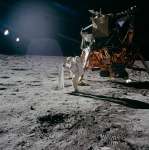 Apollo 11: Catching Some Sun
Apollo 11: Catching Some Sun
22.07.2017
Bright sunlight glints and long dark shadows mark this image of the lunar surface. It was taken July 20, 1969 by Apollo 11 astronaut Neil Armstrong, the first to walk on the Moon. Pictured...
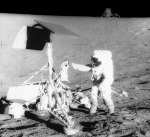 Apollo 12 Visits Surveyor 3
Apollo 12 Visits Surveyor 3
22.10.2018
Apollo 12 was the second mission to land humans on the Moon. The landing site was picked to be near the location of Surveyor 3, a robot spacecraft that had landed on the Moon three years earlier.
 Milky Way and Zodiacal Light over Australian Pinnacles
Milky Way and Zodiacal Light over Australian Pinnacles
23.10.2022
What strange world is this? Earth. In the foreground of the featured image are the Pinnacles, unusual rock spires in Nambung National Park in Western Australia. Made of ancient sea shells (limestone), how these human-sized picturesque spires formed remains a topic of research. The picturesque panorama was taken in 2017 September.
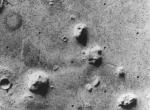 A Face On Mars
A Face On Mars
6.04.1998
This image, showing what looks to be a human face (above center) and other features of the Cydonia region on the Martian surface, was produced using data from NASA's Viking 1 orbiter in 1976.
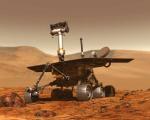 Name This Martian Robot
Name This Martian Robot
26.11.2002
NASA will launch two robots to Mars next year and you can help name them. The Mars Exploration Rovers are scheduled for launch on or near this coming June, when Mars and Earth are relatively close in their orbits.
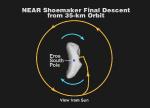 Approaching Asteroid Eros
Approaching Asteroid Eros
12.02.2001
Today, at about 3 pm EST, the first human-made spacecraft is scheduled to touchdown on an asteroid. At an impact speed of 8 kilometers per hour, it is most probable that the robot spacecraft NEAR-Shoemaker will not survive its planned collision with 433 Eros.
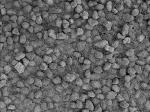 Angular Sand on Martian Hills
Angular Sand on Martian Hills
24.10.2005
Why isn't this sand round? The robotic Spirit rover currently rolling across Mars has found notably angular sand in the Columbia Hills on Mars. Previously, small bits of sand found in the plains of Gusev Crater were significantly more round.
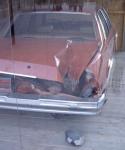 The Car, the Hole, and the Peekskill Meteorite
The Car, the Hole, and the Peekskill Meteorite
19.11.2006
The Peekskill meteor of 1992 was captured on 16 independent videos and then struck a car. Documented as brighter than the full Moon, the spectacular fireball crossed parts of several US states during its 40 seconds of glory before landing in Peekskill, New York.
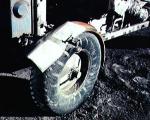 Lunar Dust and Duct Tape
Lunar Dust and Duct Tape
27.03.1998
Why is the Moon dusty? On Earth, rocks are weathered by wind and water, creating soil and sand. On the Moon, the long history of micrometeorite bombardment has blasted away at the rocky surface creating a layer of powdery lunar soil or regolith. This lunar regolith could be a scientific and industrial bonanza.
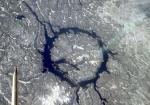 Manicouagan Impact Crater on Earth
Manicouagan Impact Crater on Earth
13.12.2000
The Manicouagan Crater in northern Canada is one of the oldest impact craters known. Formed during a surely tremendous impact about 200 million years ago, the present day terrain supports a 70-kilometer diameter hydroelectric reservoir in the telltale form of an annular lake
|
January February March April May June July |
|||||||||||||||||||||||||||||||||||||||||||||||||